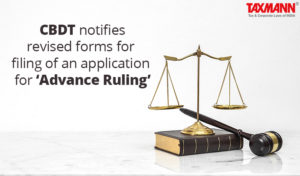CBDT notifies revised forms for filing of an application for ‘Advance Ruling’
- Blog|News|Income Tax|
- 2 Min Read
- By Taxmann
- |
- Last Updated on 14 December, 2022

Notification No. 49/2022, dated 05-05-2022
To provide an alternative method of providing prompt advance ruling to the taxpayers, the Finance Act 2021 had constituted a Board for Advance Ruling. The Finance Act 2021 had inserted a new Section 245-OB to empower the Central Government to constitute one or more Board for Advance Rulings for giving advance rulings on and after the notified date.
Later, the Govt. constituted Boards for Advance Ruling vide notification no. 96/2021, dated 01-09-2022 and also notified e-advance rulings Scheme, 2022 applicable with effect from 18-01-2022 vide Notification No. 07/2022, dated 18-01-2022.
The Finance Act, 2021 had also amended section 245Q to provide that the pending application with the Authority i.e. in respect of which order under section 245R(2) or section 245R(4) has not been passed, shall be transferred to the Board for Advance Rulings along with all records, documents or material, by whatever name called and shall be deemed to be the records before the Board for all purposes.
To enable the processing of such pending cases, the Central Board of Direct Taxes (CBDT) has amended Rule 44E of the Income-tax Rules, and also substituted Forms to carry out necessary modifications. The following are the key changes introduced by the board in Rule 44E:
-
- Word ‘quadruplicate’ removed
As per the e-advance rulings Scheme, 2022, an application for advance ruling shall be made electronically. Thus the requirement of making applications in quadruplicate became redundant and accordingly removed from Rule 44E. - Application to be digitally signed
The application for advance ruling shall be digitally signed and communication shall be done through the applicant’s registered e-mail address. The necessary changes have been introduced in Rule 44E in this regard with respect to different types of taxpayers. - Substitution of Form no. 34C to Form no. 34EA
All existing forms applicable for filing of the application in respect of the different classes of non-residents as referred to in section 245N have been substituted.
- Word ‘quadruplicate’ removed
Click Here To Read The Full Notification
Disclaimer: The content/information published on the website is only for general information of the user and shall not be construed as legal advice. While the Taxmann has exercised reasonable efforts to ensure the veracity of information/content published, Taxmann shall be under no liability in any manner whatsoever for incorrect information, if any.

Taxmann Publications has a dedicated in-house Research & Editorial Team. This team consists of a team of Chartered Accountants, Company Secretaries, and Lawyers. This team works under the guidance and supervision of editor-in-chief Mr Rakesh Bhargava.
The Research and Editorial Team is responsible for developing reliable and accurate content for the readers. The team follows the six-sigma approach to achieve the benchmark of zero error in its publications and research platforms. The team ensures that the following publication guidelines are thoroughly followed while developing the content:
- The statutory material is obtained only from the authorized and reliable sources
- All the latest developments in the judicial and legislative fields are covered
- Prepare the analytical write-ups on current, controversial, and important issues to help the readers to understand the concept and its implications
- Every content published by Taxmann is complete, accurate and lucid
- All evidence-based statements are supported with proper reference to Section, Circular No., Notification No. or citations
- The golden rules of grammar, style and consistency are thoroughly followed
- Font and size that’s easy to read and remain consistent across all imprint and digital publications are applied




